
2015.2 | 2015.1 | 2014.2 | 2014.1
2013.2 | 2013.1 | 2012.2 | 2012.1 | 2011.2 | 2011.1 | 2010.2 | 2010.1
2009.2 | 2009.1 | 2008.2 | 2008.1 | 2007.2 | 2007.1 | 2006
August – December 2010
- Other December News – December 3
- December 2010 Newsletter – December 2
- Other October News – October 11
- October 2010 Newsletter – October 4
- August 2010 Newsletter – August 3
Other December News
December 3: Georges Claeys Sells 400-Piece Mont Saint-Hilaire Collection
Sale scheduled for January 14–15, Gent, Belgium
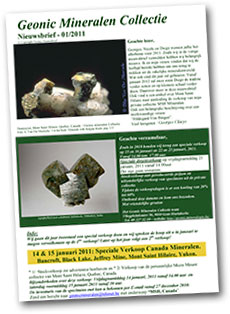 |
| This newsletter, in Flemish, provides more information regarding the sale. |
Today we received a note from Georges Claeys stating that he is selling his private collection of minerals from Mont Saint-Hilaire, Québec—about 400 pieces. The collection contains micromounts, cabinet specimens, handpieces, and two big museum pieces: a siderite and an analcime with aegerine.
Some pieces are published in the German magazine Lapis with the theme Mont Saint-Hilaire, Quebec, Canada. In 2006, some of Claeys's best pieces were exhibited at the Tucson Gem and Mineral Show in the featured Canadian exhibition.
The special sale will take place Friday, 14 Jan 2011 (14:00–16:00) and Saturday, 15 Jan 2011 (10:00–18:00). For location and details, email Geonic Minerals or visit the website.
December 2010 Newsletter
In this edition of Pala Mineralis we feature two unique specimens from two different hemispheres—western/southern and northern/eastern. We do more hemisphere-hopping: chalcedony from Central Java, jade from Guatemala, peridot from Egypt, tourmaline and emerald from Brazil, and shows in Arizona, France, and Munich. The virtual world is well represented by three online resources, and we look at the micro-world of other worlds. Slip off the shoes, sit back, and savor…
Shows and Exhibitions
Pala International News
- Pala’s Featured Mineral Specimens
- Bill Larson to Speak in Dallas and Tucson
- Reprint: Mineralogical Record Report on Ste-Marie Show
Mineral and Mineralogy News
Chips & Chunks
Recycle Bin
Shows and Exhibitions
Tucson Time – February 1–13, 2011
After the holidays, we’re looking forward to the world’s greatest gem and mineral show in February. One-stop general information about individual shows can be obtained from the Tucson EZ-Guide.
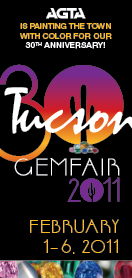 |
Pala International will be represented in Tucson as follows. We look forward to seeing our many friends there. Visit the Pala International Show Schedule for future events.
AGTA GemFair
Pala joins nearly 100 exhibitors for this annual extravaganza.
Event: AGTA GemFair
When: February 1–6
Where: Tucson Convention Center
Booth: 1016
The event website now features an interactive floorplan allowing you to see who is exhibiting by area of the convention center.
A list of seminars was released just as our newsletter went to e-press.
10th Annual Westward Look Mineral Show
Pala International and two dozen other world-class mineral dealers shack up at a Sonoran Desert resort.
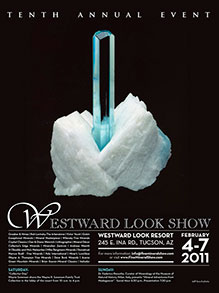 |
- Collector Day (Sat) features Wayne Sorensen and selections from the private collection of the Wayne R. Sorensen Family Trust
- Mineral Adventures from Madagascar (Sun) is a presentation by Dr. Federico Pezzotta, curator of mineralogy at the Museum of Natural History in Milan. View a portrait of Dr. Pezzotta and some of his institution’s specimens as well as his personal treasures from Elba Island
Event: 10th Annual Westward Look Mineral Show
When: February 4–7
Where: Westward Look Resort
Suite: 224
See Pala International’s page on the Westward Look Show site.
57th Annual Tucson Gem and Mineral Show
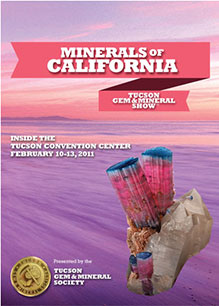 |
TGMS is the largest gem and mineral show in the country. This year’s theme is “Minerals of California,” so it was natural that Pala’s Bill Larson would be asked to make a presentation on the subject.
Event: 57th Annual Tucson Gem and Mineral Show
When: February 10–13
Where: Tucson Convention Center
Booth: Aisle 5 East
We received a preliminary list of presenters for the 2011 show:
- Robert James, president of International School of Gemology: “Forensic Gemology and the New Generation of Treatments”
- Courtenay V. Smale, retired chartered mining engineer: “The Williams Collection of Caerhays Castle, Cornwall”
- Vandall King, consulting mineralogist and author: “The California Minerals You Want to Own”
- Bill Larson, president of Pala International: “Fabulous Treasures from San Diego Gem Mines” (see details below)
- Anthony Kampf, curator of The Natural History Museum of Los Angeles County: “Treasure Trove of New Minerals”
- Wayne Leicht, expert on gold specimens and proprietor with Dona Leicht of Kristalle gallery: “California Gold Rush”
- Erik Stewart, Tucson-area jewelry designer: Topic to be announced
[back to top]
Tucson Transit Tips
Many shows will offer their own shuttles. View your transit and parking options here. [back to top]
And speaking of Tucson…
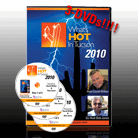 |
A little bird told us that BlueCap Productions will offer at Tucson 2011 the first volume in a Collecting Minerals video series. Collecting Minerals: Thumbnails will feature specimens from the likes of Wendell Wilson, Carolyn Manchester, and Rich Olsen, and will fill the screen in 360-degree glory as the collectors reminisce on each piece.
Tucson 2010 was well documented by BlueCap with a 3-DVD set, What’s Hot in Tucson, devoted to minerals and a separate DVD focusing on gems and jewelry at the AGTA GemFair.
Attention Holiday Shoppers: Friends of Pala International get a 10% discount on any BlueCap order. Just enter the code palaintl when you’re asked for it while ordering.
And Munich?
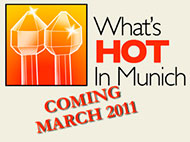 |
A month after Tucson, BlueCap is slated to release a new What’s Hot. This one takes the viewer to Mineralientage München, Europe’s largest mineral show. The October 2010 show featured some impossibly precarious tourmalines from Brazil’s Minas Gerais, which What’s Hot In Munich captures backstage.
Subscribers to Mineralogical Record will receive their own copies free of charge, with the March–April issue.
 |
| From Minas Gerais. Palaminerals.com offers some lovely and affordable tourmalines from the locality featured this year at the Munich show. This one was just added yesterday. At the base of this glassy, gemmy crystal is a quartz with a crossing tourmaline coated with lepidolite mica. Inventory #18813. (Photo: John McLean) |
[back to top]
Pala International News
Pala’s Featured Specimens: Peruvian Fluorite and Austrian Epidote
This month we feature a lavender fluorite from Peru and an epidote from Austria.
Fluorite from the Huánuco Department, Peru
This is a peculiar fluorite crystal composed of interlocking beveled cubes. It’s almost surreal to fumble this miniature mineralscape around in your hands. This is a true work of art from Mother Nature: a floater, almost complete all the way around, with only a few contact points. There are a couple of trace pyrite crystals on the back side. The specimen was found at the Huanzala Mine in Peru, which is known for fine specimens of fluorite and pyrite while production of lead and zinc can reach up to 1200 tons per day.
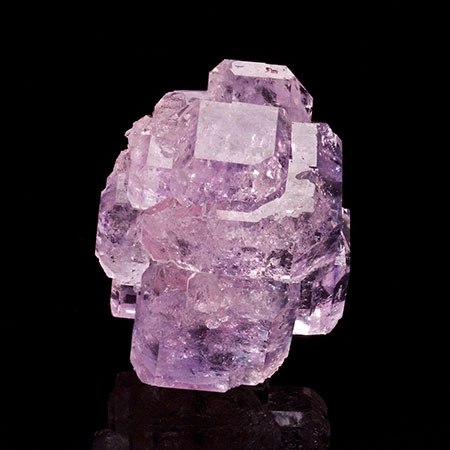 |
| Lavender fluorite. This fluorite (click to enlarge) comes from the Huánuco Department of central Peru. Dimensions: 5.4 x 4.7 x 4.2 cm. Inventory #18830. (Photo: Mia Dixon) |
Epidote from Knappenwand, Austria
The epidote comes to us from the historic Knappenwand Mine in Austria, on which we reported recently.
Large fine epidotes are extremely rare from this locality, and the association of calcite and bissolite makes this piece one-of-a-kind. The geodesic-like calcite creates a solid foot for this long and complex epidote; then the sprinkling of bissolite adds to the character. The main epidote crystal is striated and well formed with a curvature at the top and many intersecting, smaller epidote clusters. There are some contact points on the back, but it is very complete from the front. A superb matrix specimen from a classic locality.
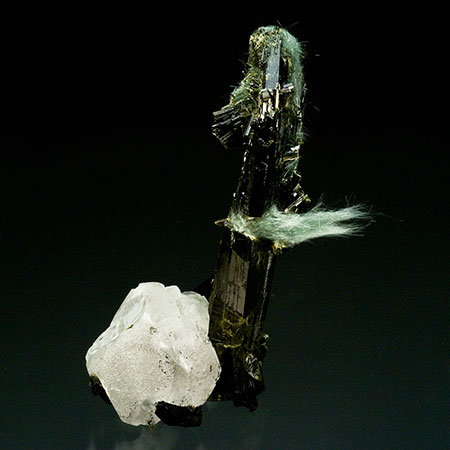 |
| Epidote. This epidote (click to enlarge) features delicate bissolite filaments. Dimensions: 12 x 6.2 x 5 cm. Price available upon request. (Photo: Mia Dixon) |
Interested? Call or email us to inquire. [back to top]
High End Specimens on Palaminerals.com
Visitors to Palaminerals.com will be familiar with The Bargain Bin. But recently we received a request for an easy way to browse the higher end…
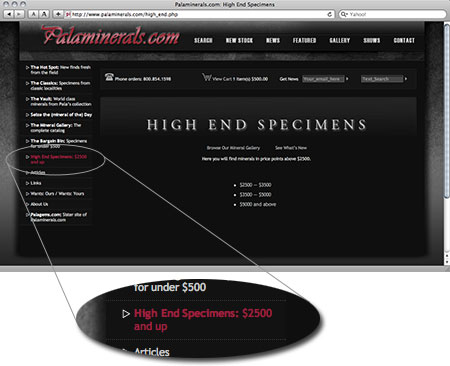 |
| New Link. We’ve added a new category to Palaminerals.com—High End Specimens—with three subcategories to choose from. |
[back to top]
Bill Larson to Speak in Dallas and Tucson
Members-only and public dates announced
Pala International president Bill Larson will speak to a members-only event of The Dallas Woman’s Club, Thursday, January 27, 2011, at 11:00 a.m., at the Club building, 7000 Park Lane. Bill’s topic is “Precious Gemstones: Mined, Refined and Designed.” The Club telephone number is 214.363.8370.
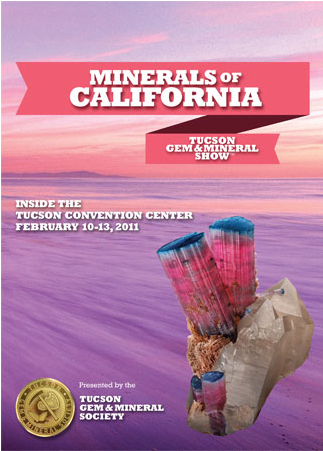 |
| 2 x 2. If you missed Bill Larson’s display at TGMS 2008 (see Mindat.org coverage), which included the “Rabbit Ears” specimen that graces this year’s poster, you’ll have another chance. The 24-cm. tall specimen will be on loan again from the Houston Museum of Natural Science at the 2011 show. It’s from the Tourmaline Queen Mine in the Pala Mining District of San Diego County. |
In keeping with its theme, “Minerals of California,” the 2011 Tucson Gem and Mineral Show will feature Bill Larson speaking on the topic of California tourmalines.
Speaker: Bill Larson
Presentation Title: “Fabulous Treasures from San Diego Gem Mines”
What: 57th Annual Tucson Gem and Mineral Show
When: Saturday, February 12, 2011, 2:00–3:00 p.m.
Where: Tucson Convention Center
Room: Turquoise Ballroom (TB)
 |
| Yes, we have no blue-caps. But we do have a couple-dozen tourmaline selections, such as this peek-a-boo trio from the John Grieger Collection, which sports a stocking-stuffer price. Inventory #14843. (Photo: John McLean) |
[back to top]
Reprint: Mineralogical Record Report on Ste-Marie Show
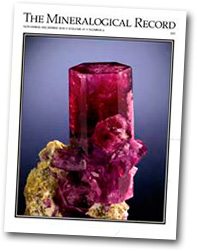 |
Larsons provide expanded account
In our last issue of Pala Mineralis, we featured an abbreviated report from Pala’s Will Larson regarding the 2010 Euro-Mineral & Euro-Gem shows at Sainte-Marie-aux-Mines.
The full report—by Bill, Will, and Carl Larson—has been published in the November–December issue of The Mineralogical Record, and we’re pleased to provide a reprint of it here. It covers four days of highlights from the show
In the reprint, we’ve included some new photographs from Carl Larson.
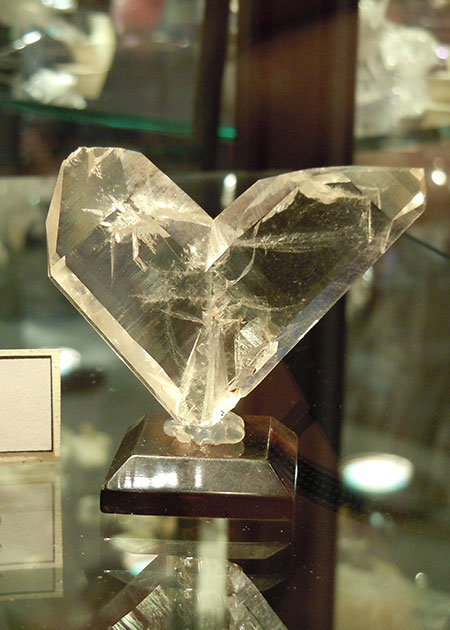 |
| A nice Japan law twin from a special display of quartz from France. (Photo: Carl Larson) |
Also at The Mineralogical Record
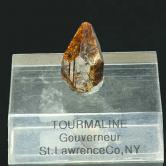 |
In his “What’s New in the Mineral World” column on The Mineralogical Record website, Thomas P. Moore mentions the Palaminerals.com website in general, and discusses in particular a uvite-dravite (aka tourmaline, pictured at right) from our catalog.
[back to top]
Mineral and Mineralogy News
Indonesian “Fossil Bamboo”
Recently, we added some chalcedony stalactites from Central Java to the online catalog at Palaminerals.com.
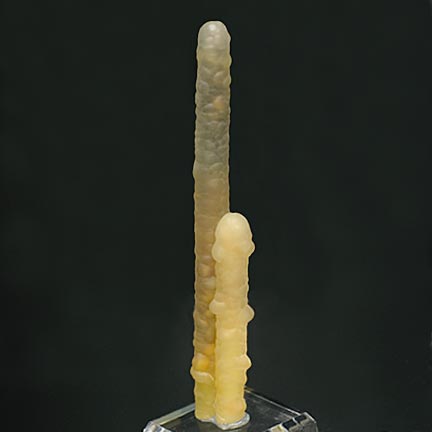 |
| Joined at the hip. Two chalcedony stalactites with hollow center tubes. Inventory #18772. (Photo: John McLean) |
In the course of reviewing online information regarding these specimens, Pala’s John McLean came across a page about similar material on IndoAgate.com—the self-described “one man show” of entrepreneur Joel Ivey. After hearing about a discovery in Central Java of “clusters of agate tubes” in early 2009, Ivey decided to seek out the source of the material. He describes what he found in Indonesian Fossil Bambu.
Ivey told us last week that he was in the field with a paleobotanist, with the goal of identifying the original plant genus involved in the bamboo “fossils” and further defining “the genesis of the material.” He will update the above-referenced page accordingly later this month.
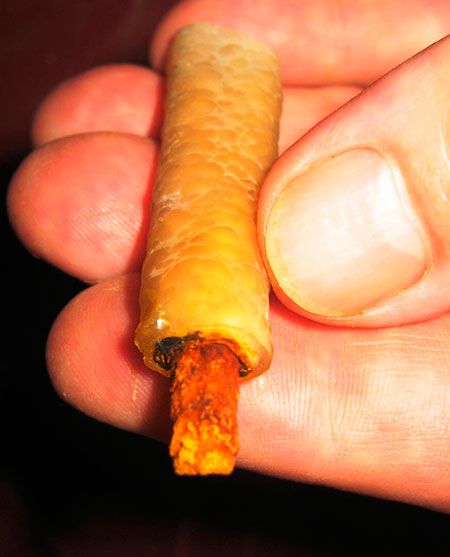 |
| Clogged artery. The “guts of a finger agate” from a remote area in Central Java, southern Indonesia. (Photo: Joel Ivey) |
We should note that, according to Mindat.org, the term agate refers to a subvariety of chalcedony displaying concentric bands, “often in rather wild patterns.” If it’s wild patterns you’d like, look no further than East Java, for plume agate. According to Ivey, this material (pictured below) “is hosted in orange red jasper which has been splintered by faulting and flooded with blue-ish white chalcedonic quartz veins.”
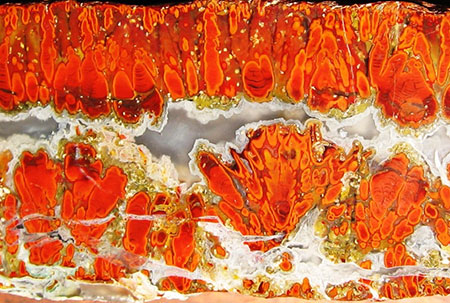 |
| East Java plume agate, achieved by a parallel cut; a perpendicular cut would display “pods, orbs, or caterpillar shapes” in the material, according to Joel Ivey. (Photo: Joel Ivey) |
There’s a lot more to see on IndoAgate.com. [back to top]
Online: GéoForum and -Wiki, Virtual Mineral Museum
French and American sites for virtual perusal and more
We received two notes last week about mineral sites from New York, NY and Lille, France.
Frédéric Delporte, who collects French specimens and is “impassioned” about the mineralogy of France, is also impassioned about two French websites devoted to all aspects of earth sciences.
GéoForum is a space devoted to discussions of Earth Sciences, the Geological Heritage in the community life around the geology or geological events. The forum made 100,000 visits per month and 350 to 450,000 page views. Reference site in its field in France.
GéoForum offers discussion opportunities in Geology, Mineralogy, Micromineralogy, Paleontology, and Vulcanology, as well as events, galleries, and more.
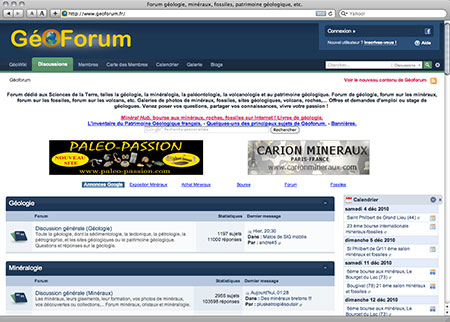 |
| Fun for francophones. Both these websites encourage participation as well as browsing. |
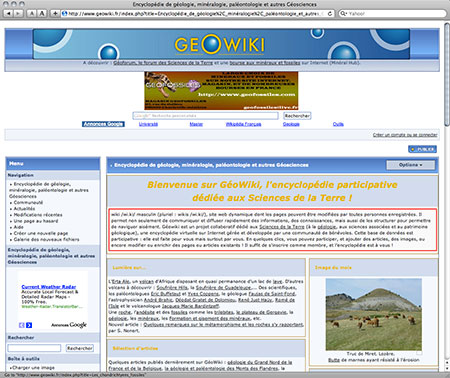 |
GéoWiki is an encyclopedia dedicated to geology, mineralogy, paleontology, volcanology and other Earth sciences. Everyone can enrich by registering as a member.
GéoWiki has a nice emphasis on regional information, as demonstrated by a listing of selected articles on the home page:
geology of the Far North of France and Belgium, the geology and paleontology of the Mounts of Flanders, the geology of Boulonnais, the minerals of France, the color of crystals, Uranium, the geology of the Armorican Massif, the internal composition of the Earth, Iceland or the birth of a new world, the meteorites: stones that fall on us from the sky, the mines of Steinbach (68), Les Mines de Potasse d’Alsace au fil du temps, crystallography, oil, basalt, the fossil chondrichthyes, pseudomorphs, macles, volcanic risks in Europe, the trade of the geologist,…
John Betts, a purveyor of fine minerals, pointed us to his non-commercial Mineral Museum—“strictly a reference site for collectors.” Betts told us that the virtual museum contains 67,000 images of 30,700 mineral specimens. The home page gives an indication of the bounty: 734 “A” minerals alone are listed. Choose another letter of the alphabet and then choose your mineral.
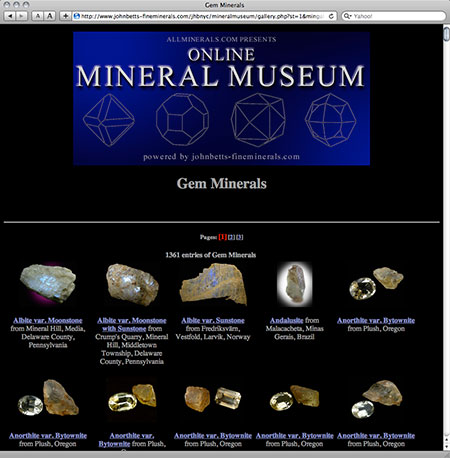 |
| Gem Minerals. One of several pre-selected groupings that have been assembled for your browsing pleasure. |
Scroll down to the foot of the page for useful categories—mineralogical and locational—such as the Gem Minerals section pictured above. Pseudomorphs? Betts has over 800 in alphabetical order. Over 1,000 specimens in a Native Elements category. Just the thing for a quick reference or an extended browse… [back to top]
Chips & Chunks
The Meteorite Imagery of Jeff Hodges and Michael Cranford
Thin-section collector and photographer
collaborates with fine artist for out-of-this-world imagery
No, thin section is not the news portion of your Sunday newspaper. It’s a technique of polishing extremely fine slices of mineral material for microscopic study. By extremely thin, how about 30 microns—thin enough for light to pass through? Collector and photographer Jeff Hodges, according to an interview in Meteorite-Times Magazine, has pushed the polishing envelope. His zeal for photography-friendly slices caused him to “attempt the impossible” and see whether if the lab he uses might go the extra micron—to a thickness of 1 micron on the mounted side and ¼ micron on the top. (Mounting some material with epoxy is impossible at such thicknesses.)
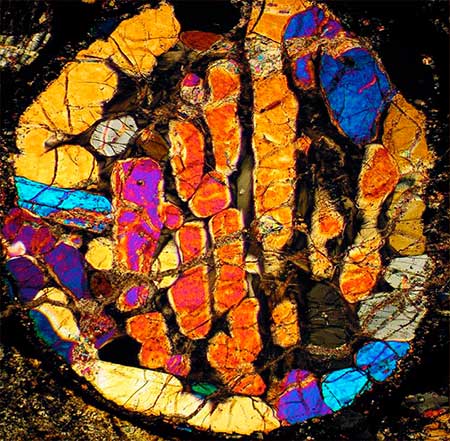 |
| Title: Cosmic Cactus. The thin-slice depicted in Michael H. Cranford’s work above comes from NWA 2892 H/L3, discovered in the Sahara Desert (North West Africa). See more at Meteorites Australia. (Image: Michael H. Cranford) |
What Hodges collects and photographs, artist Michael H. Cranford renders in mixed media paintings combining photography and acrylic paint on canvas, according to the artist’s website. “Science and art collide,” he wrote to us before the 2009 show in Denver. Cranford’s day job is hardly down-to-earth: he designs tropical treehouses in Costa Rica (among other things).
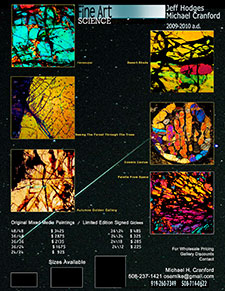 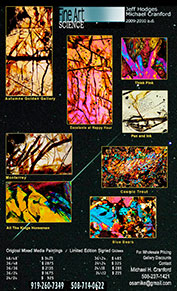 |
| Click on the thumbnails above. More information is available at The Meteorite Thin Section Gallery. |
[back to top]
“Bahia” Emerald Jinxed?
Friends don’t let friends buy 840-lb. rocks
Last month, in our gemstone newsletter, Palagems Reflective Index, we noted the testimony of Anthony Thomas, who claimed he was swindled out of possession of the 840-lb. “Bahia” Emerald after its true value was realized—a swindle aided and abetted by a man he considered a friend.
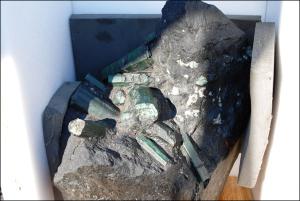 |
Monday, the San Francisco Chronicle published a story titled “Bahia Emerald legal battle tears 2 friends apart.” It begins by questioning whether an item of commerce that destroyed a friendship might be cursed. One of the lawyers involved, Eric Kitchen, demurred, calling the “Bahia” a “magnificent creation” of nature. If anything is jinxed, he said, it’s the attitude taken by mere mortals toward the stone.
The trial is scheduled to resume December 14 in Los Angeles, according to a November 19 press release. “A trial date as to Mark Downie’s ownership claims to the Bahia Emerald has not yet been announced,” the release stated. As we noted before, the complicated case—which has had over 12 claimants, according to the Chronicle—is revealed by its title(s): Ken Conetto By Eric Kitchen His Attorney In Fact (Petitioner) vs. Kit Morrison and Todd Armstrong (Respondents); Mark Downie (Intervenors) vs. Eric Kitchen et al., Kit Morrison and Todd Armstrong (Respondents), Case No. BS118649.
On September 8, 2010, Respondents Kit Morrison, Todd Armstrong, Jerry Ferrara, FM Holdings, Inc., and Market Link, Inc. reached an undisclosed settlement with Petitioners Ken Conetto and Forrest Wayne Catlett. [back to top]
Recycle Bin
Archaeology of Zabargad Island
Researchers report on peridot mining in the Red Sea
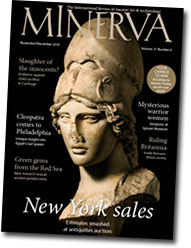 |
A longer version of this article appeared last month in our gemstone newsletter, Palagems Reflective Index.
The topazos of the classical Greeks and Romans is the modern peridot, the transparent yellowish-green gem variety of the mineral olivine. Ancient writers said it came from the island of Ophiodes (Snaky) or Topazos in the Red Sea between Egypt and Arabia. Today the island is called Zabargad, the Arabic word for peridot, and also sometimes Saint John’s.
Commercial peridot and garnierite mining occurred there during the first half of the 20th century, but since then the island has been abandoned except for the occasional temporary military camp. Although much has been written about Zabargad’s unusual geology and modern workings, the ancient mine has not been reported until now. In an article appearing in the November/December issue of MINERVA magazine, James Harrell (University of Toledo, USA) and Elizabeth Bloxam (Monash University, Australia) provide the first description of the ancient mine.
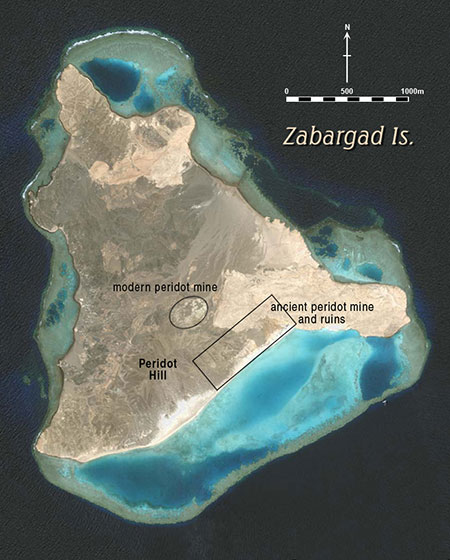 |
| Satellite map of Zabargad Island, Egypt, above. Gem quality peridot specimens, below (click to enlarge), from modern and ancient mines on Zabargad Island, collected by James Harrell, 2010; cabochon (12.7 x 9.9 x 3.9 mm.) from modern mine purchased in Cairo market in 2009. (Photo: Lisbet Thoresen) |
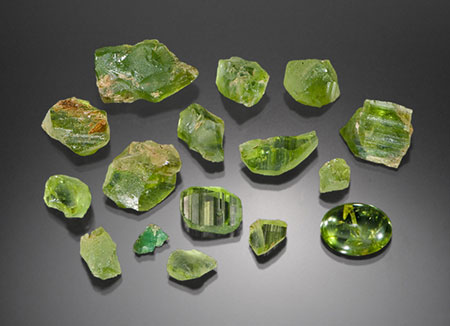 |
Located on the island’s southeast shore, the ancient mining site consists of roughly 150 surface pits, which individually are up to 20 m. across with adjacent spoil piles as high as 5 m. Also associated with the mine are the ruins of stone dwellings and a water well. Pottery fragments, which are especially common around the well, date mainly from the 3rd to 1st centuries BCE of the Hellenistic period with the rest extending into the Roman period.
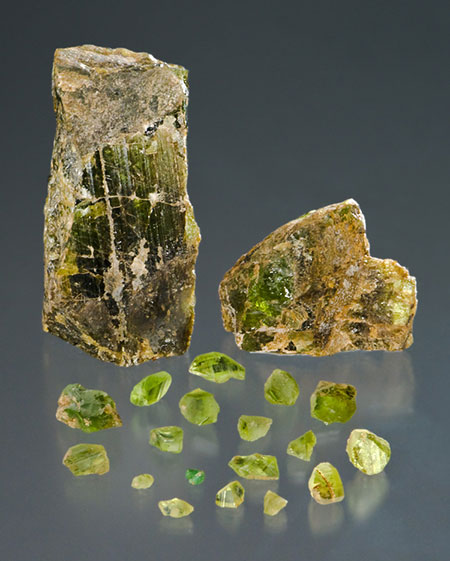 |
| Specimens of gem quality peridot (click to enlarge) from the ancient mining site on Zabargad Island. Collected by James Harrell, June 2010. (Photo: Lisbet Thoresen) |
Thank you to Drs. Harrell and Bloxam, and also to Lisbet Thoresen for facilitating this article. [back to top]
George Harlow on the “Trail of Green Rocks”
The following also appeared in last month’s edition of Palagems Reflective Index.
Dr. George Harlow, curator of gems and minerals at the American Museum of Natural History, has posted a two-part overview of his trip last month with the jaderos (jade researchers) of Guatemala in the Motagua Valley. The team of geologists were researching the origins of the area’s jade, which is a surviving legacy of prehistoric Mayan artistry.
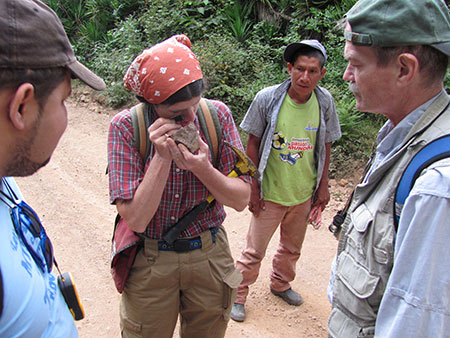 |
| Got green? Kennet Flores (Post-Doctoral Fellow at AMNH), Jinny Sisson (University of Houston), a local Chorti, and George Harlow checking out rocks near Camotán in Guatemala. (Photo: Jamie Newman, courtesy of the American Museum of Natural History) |
In these posts, Dr. Harlow discusses the origins of the Caribbean region and its “theme of green rocks” that includes jadeite and serpentinite. By the good fortune of a shortcut, the group saves time and effort in successfully pursuing their green goal. Read “On the Trail of Green Rocks” and “In Search of a Jade Host Rock,” at the blog Scientist at Work, a electronic field journal crafted by Stuart Sandin, associate professor at Scripps Institution of Oceanography’s Center for Marine Biodiversity and Conservation, hosted by The New York Times. [back to top]
— End December Newsletter • Published 12/2/10 —
Other October News
October 11: National Geographic Channel Presents:
Into the Lost Crystal Caves
Naica Caves documentary to air twice more this Thursday
National Geographic Channel will air a new documentary about the “lost” crystal caves at Naica, Chihuahua, Mexico, twice on Thursday, October 14. (Check times here; be sure to set your time zone.) The two-hour program premiered last night, and from what we’ve seen, it deals with a multidisciplinary interest in the caves, from microbiology to space travel, beyond the danger, danger, danger tattoo that is the lure of such television programming.
Naica’s famous selenite crystals were created in a stable environment of warm, mineral-rich water (as discussed in a 2006 Geology article), and discovered by accident as miners looked for lead, zinc, and silver. The crystals, now available for study as water has been removed from their caves, are the size of telephone poles, weighing up to 55 tons. (Other crystal caves, covered in the documentary, exhibit other features.) The caves are not hospitable, however, with their ambient temperature of 113°F and 90% humidity. Expeditions into the caves have been facilitated by the donning of “ice suits” and respirators that cool the skin, lungs, and eyes. Think “poached eggs” and you’ll have an idea of what five minutes of unmitigated cave exploration can do to the human body.
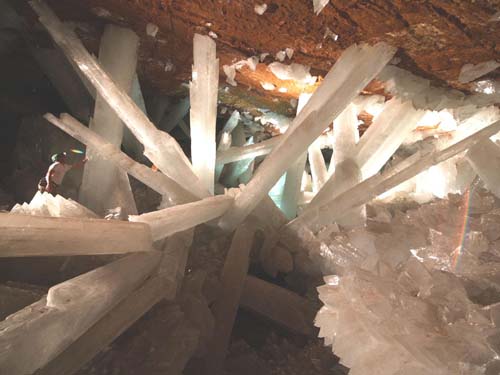 |
| Antediluvian. These caves may be flooded with water once again after nearby mining of minerals with industrial value is completed. (Photo: Source unknown) |
The documentary, Into the Lost Crystal Caves, is a co-production of Canada and Mexico, distributed by National Geographic (NG). “For more than five years,” director Gonzalo Infante of Speleoresearch & Films “has tirelessly worked to share the wonders of Naica with the world and to preserve them for future generations,” a reference to the fact that the caves likely will not remain drained, as explained by Paul Williams, who visited one cave for another NG series.
See also the Naica Project website. [back to top]
October 2010 Newsletter
In this edition of Pala Mineralis we feature a remarkable specimen from the Hunza Valley of northern Pakistan, which in January suffered a landslide that created a threatening artificial lake. Pakistan is facing a tremendous challenge due to flooding. Please join gemologist Antoinette Matlins in her effort to hasten aid to Pakistan through her personal connections in the country.
Shows and Exhibitions
- Mineralientage München: Oct. 29–31, 2010
- Saint-Marie-aux-Mines 2010: A Report by Will Larson
- Mile-High Mirth-Maker
Pala International News
Mineral and Mineralogy News
- Databases on Parade
- Emerald Aisle
- Bahia Emerald Has Its Day in Court
- Bello smeraldo peruviano colombiano
- Early Harvest of Green on North Carolina Farm
Recycle Bin
- Mineral Mélange: Rubellite matrix offered at Burma sale
- Going for the Gold: Famous ingot got gone
Shows and Exhibitions
Mineralientage München 47th Munich Mineral Show
October 29–31, 2010
Brilliant Brazilians and Blancans
Pala International’s Bill Larson and Will Larson will attend this major gem and mineral show…
This year’s special exhibit is titled “Arco Iris: the Brazilian Gemstone-Rainbow over Munich.” The show website describes it like this: “The seven color wonders of the rainbow-collection will make the visitors quite literally walk on air. An exclusive show that has never been seen before!”
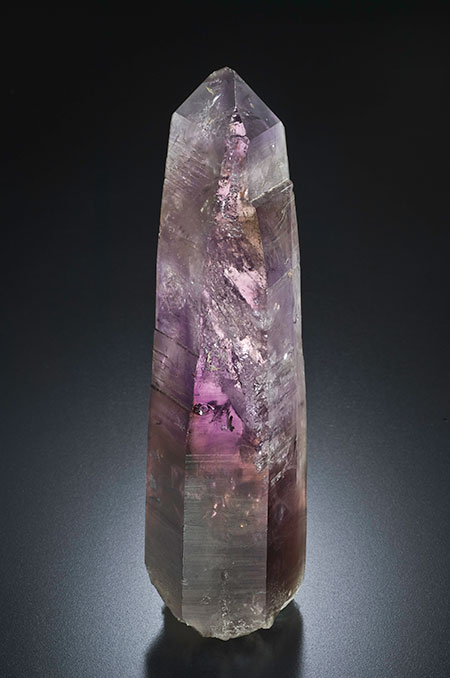 |
| Amethyst crystal from Traversella, Italy, to be exhibited in the Alpine section of the show. The crystal is 14 x 4 cm., with fluid-inclusions. From the collection of Tiziano Bonisoli of Turin, Italy. (Photo: Jeffrey Scovil) |
This year’s show also features “Mont Blanc: Crystal Treasures from Europe’s Rooftop” as the alpine highlight, and will include red fluorites. The region takes its name from western Europe’s highest mountain and is home to the famous Chamonix—so famous that collectors must obtain a permit from the mayor’s office. To the south is Italy’s Aosta Valley, with dozens of localities, many of which will be represented. The larger alpine exhibit, of which this is the centerpiece, will include emeralds from Habachtal and treasures from Traversella, in addition to the Alps’ largest gold and mineral finds.
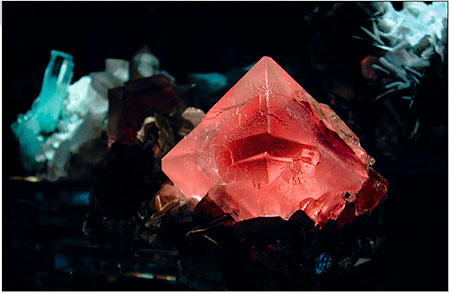 |
| Red fluorite from Pakistan. Cousins from Mont Blanc will be displayed, also in the Alpine section of the show. (Photo: Zeisberg) |
For more information visit the show website. See the Pala International Show Schedule for future events.
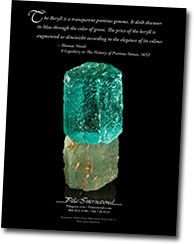 |
| See our ad in this year’s program. |
[back to top]
Saint-Marie-aux-Mines 2010: A Report by Will Larson
VIPs to Consider Berlitz Total Immersion in Taverne du Mineur
Another year in France and this one is just as good as the rest, at least the food and wine, that is! We drive in from Frankfurt, straight to the mineral show and after separating from my father [Bill Larson], we three musketeers, my brother Carl Larson, Mark Kauffman, and myself, stand in front of the Taverne du Mineur on the street of Sainte-Marie strategizing how to get into the show. The people of the show, several minutes earlier barred us from getting in, for God knows what reason, because apparently our VIP badges weren’t VIP enough! The two female security guards didn't speak a lick of English and we couldn’t speak a lick of French, so as we were lost in translation we waited and abated. My father shows up like a magician from inside the show and manages to get across the name Michelle Shwab, and like magic, they let us in...
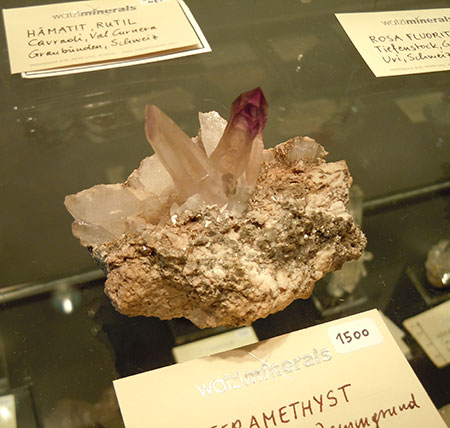 |
| Amethyst scepter on matrix, from Switzerland, offered by the Watzl brothers. (Photo: Will Larson) |
Day one at the Sainte-Marie show was quite a busy day. We enter the show and hit up the mineral dealers that are set up. As I walk up the steps into the theater (l’Espace Prestige; see map here), on the right side is Spanish dealer Luis Fernandez Burillo’s booth in his usual corner. I peek over to see that Luis is not fully set up but he is opening boxes full of beautiful new fluorites from Peru. These catch my eye, as they have a beautiful purple color and fantastic luster, quite different from anything I’ve seen before. After setting one aside, I pushed forward wandering inside the theater.
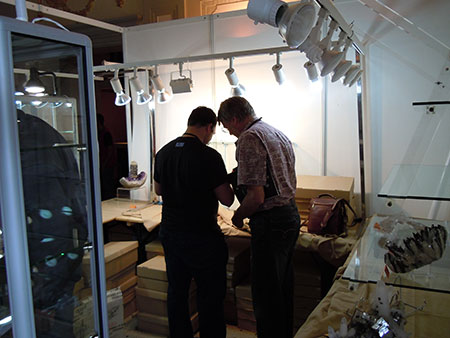 |
| When the cat’s away… Will and Bill Larson will play. (Photo: Carl Larson) |
For a moment I survey my surroundings. Many of the dealers are not set up and there isn’t much to see. I decide to take a decisive action and head outside, straight for Gilles Emringer’s booth, across from the theater’s entrance. His booth is full of beautiful fluorites, previously in his private collection. Ones to note were a bright yellow gemmy fluorite from Germany and a beautiful mint green fluorite from Sweden. Such rarities don’t find their way to the market often!
Back in the theater, on the left side this time, Alain Martaud is busy setting up his booth when he pulls us aside to show the most unusual book. Inside the book the first few pages have tests written in handwriting with very beautiful script, but after turning a few pages we notice that there is in fact a small mineral collection and notes on the pieces—a fantastic piece of history!
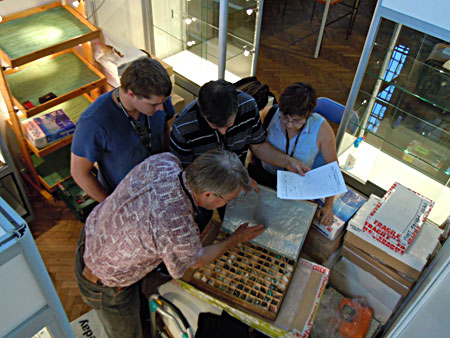 |
| Need help unpacking? Carl and Bill Larson (left and front) give Alain and Caroline Martaud a hand, just to make sure everything’s in order. Note the lovely parquet floor of the theater—surely one of the more charming venues for a mineral show in the world. (Photo: Will Larson) |
Next up I continue, climbing the stairs onto the theater stage where I meet the Watzl brothers. They always have fantastic things with such eloquent aesthetics. One fantastic piece to note is a very beautiful amethyst scepter on matrix from Switzerland! This piece (pictured above) is surely very rare and in perfect condition, making it a really unique piece.
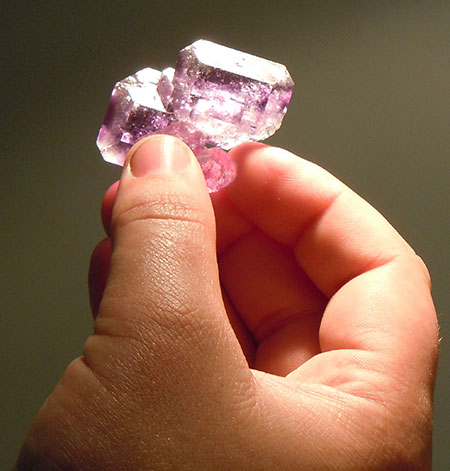 |
| Purple fluorite. From a new find in Peru. (Photo: Carl Larson) |
Continuing on we see many more things, but after outputting such energy on the first day the jet lag begins to kick in and, like slow molasses pouring from a jar, my body begins to revolt against me. Luckily I am not the only one among my party that has been caught by jet lag. Thus we decide to return home, but not before hitting up Super U! We grab a fine chilled Pinot Noir wine that is famous from this area, along with some of the delicious local cheeses and sausages for dinner. Relaxing in the early evening we watch the demise of the French World Cup team to South Africa over our delicacies.
Day two… Our readers can look forward to a full report via another perspective in The Mineralogical Record, November–December issue. The 2011 Euro-Mineral & Euro-Gem at Sainte-Marie-aux-Mines is scheduled for June 23–26.
2011 Calendar Features Work of Bruno Cupillard
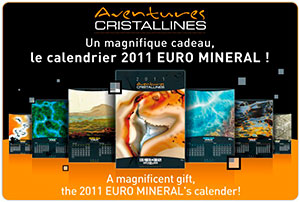 |
The 2011 Euro Mineral Calendar is now available. It features seven photographs by artist Bruno Cupillard, whose Adventures Crystallines we profiled in our FotogFocus “look at the artists behind the camera.” [back to top]
Mile-High Mirth-Maker
This photo may well have gone viral at the show in Denver two weeks ago.
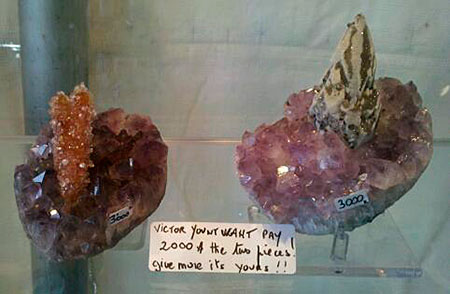 |
As Bill Larson wrote after receiving it from a fellow dealer, “A sign of the times…” [back to top]
Pala International News
Pala’s Featured Specimen: Pink Fluorite from Pakistan
This month we feature a fluorite full of beauty. At first you notice the subtle pastel pink hue and then the complexity of the crystal formation. It’s like a big scoop of strawberry ice cream topped with a little muscovite flower.
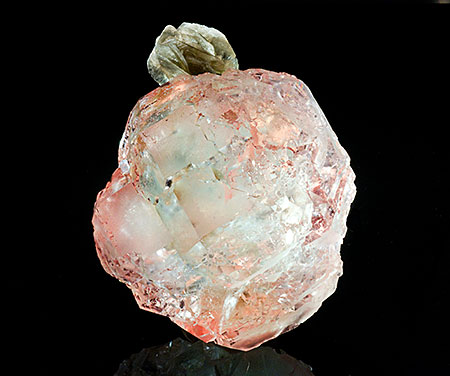 |
| Pink fluorite from Pakistan. This fluorite was found near Nagar, a small village in the Hunza Valley of Northern Pakistan. Dimensions: 10.5 x 8.5 x 6 cm. Price available upon request. (Photo: Mia Dixon) |
Frozen in time, this jewel glows with enticement and intrigue. It’s a mix of glassy and frosted faces covering a gemmy core that plays with the light and creates a unique impression. This is one of the many specimens acquired at last month’s Denver show.
Will Larson to Speak on Gem and Mineral Mining
Fallbrook Gem and Mineral Society, November 11, 2010
Will Larson will speak at the November 11 general membership of the Fallbrook Gem and Mineral Society. His subject of his presentation will be gem and mineral mining projects that he has worked on, past and present.
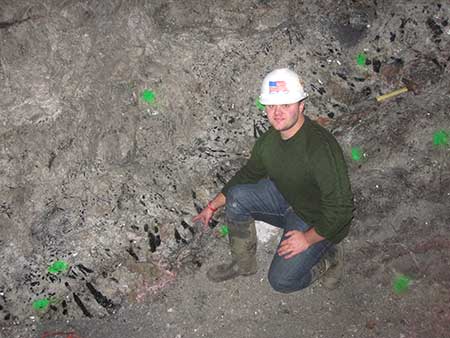 |
| Will Larson points to black tourmalines at the Oceanview Mine last December. |
The meeting will be held from 7:00 to 9:00 p.m. at the Society meeting hall, 123 W. Alvarado Street. Contact information is available from the Society website. [back to top]
Mineral and Mineralogy News
Databases on Parade
A cavalcade of mineralogical data at your fingertips
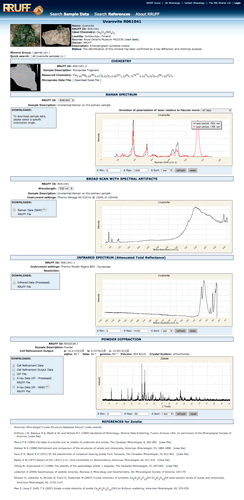 |
In the second issue of our fledgling mineral newsletter, back in 2006, we looked at the RRUFF™ Project, a website that provides users with integrated data on Raman spectra, X-ray diffraction, and chemistry for minerals—terrestrial and extraterrestrial.
Today, the add-ons now available to users make this a very versatile resource.
Due to the availability of hand-held Raman spectrometers, which use non-destructive technology, mineral collectors can compare their own data against the RRUFF Project database, which profiles thousands of samples.
A given sample page includes:
- Photos/photomicrographs (if available) in high resolution
- Raman spectra
- Infrared spectrum
- Powder diffraction patterns
- Measured chemistry
- Origin
- Reference material
- Data downloads
References are searchable via their own input form. Results returned usually include a PDF of the article, making this a useful virtual library, due to the collaboration of six mineral societies.
Sample pages include links to the American Mineralogist Crystal Structure Database Record, which point to PDFs of the journal’s articles on a given mineral. (Beryl returned 77 records.)
Also accessible via RRUFF is the International Mineralogical Association’s Database of Mineral Properties, pictured below. This tool allows you to view the chemistry via four sources. Want to see the data on a given mineral from Mindat.org or Webmineral.com? Just click a button.
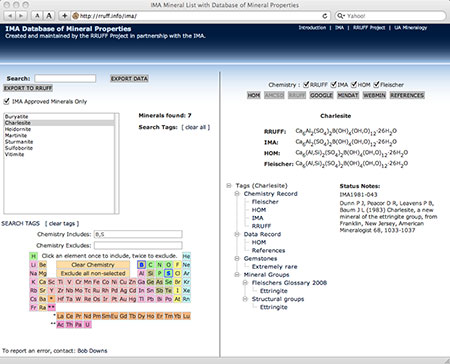 |
| Build your own mineral. By selecting one or more elements in the periodic table at left you can filter the list of 4,400+ minerals that displays above the table. |
The project is in need of thumbnail samples of very rare minerals, listed here. For background on mineral spectroscopy, see the pages of Caltech’s George Rossman, who also has collaborated in the project. [back to top]
Emerald Aisle
Bahia Emerald Has Its Day in Court
 |
Finally, the case of the 840-lb. “Bahia” Emerald is proceeding in Los Angeles. Claiming to be the specimen’s first buyer, Anthony Thomas, spent several hours on the stand, and said he bought it in 2001 for $60,000 not long after it was mined in Bahia, Brazil. According to Thomas, the money he wired to the Brazilian owners never arrived. Even though he traveled to Brazil, technically Thomas seems not to have taken physical possession of the emerald, supposedly returning to the U.S. for a family emergency without crating the rock and then losing the bill of sale in a 2006 fire.
Other claimants had their own take on the sequence of events, as reported in a September 24 Associated Press story that was carried by media from the Los Angeles Times to Huffington Post to The Guardian (UK).
A September 30 press release stated that the bench trial will continue on October 26. Another claimant, Mark Downie, will have his case heard separately on a date to be announced.
See our previous stories on the emerald February 24, March 4, and March 18, 2009, [back to top]
Bello smeraldo peruviano colombiano
Ronald Ringsrud, author of Emeralds, A Passionate Guide, spent time in Italy not long ago, and discovered a lovely specimen, pictured below, in the Mineralogical Museum at the University of Rome.
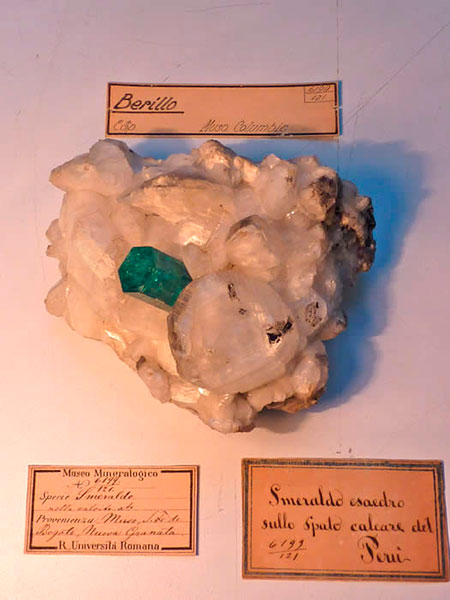 |
| Clash of appellations. Notice that the tag at top reads, Muso Columbia, while the one at lower right mentions Peru. (Photo: Ronald Ringsrud) |
In his recent e-newsletter, Ringsrud explains why the tag lists the origin as Peru, rather than Colombia.
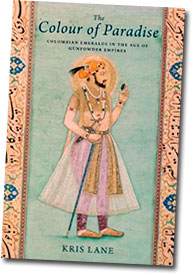 |
Ringsrud also points to another book on emerald, published last spring, Colour of Paradise: The Emerald in the Age of Gunpowder Empires, by Kris Lane, professor of history at the College of William and Mary.
Dr. Paul Drinot, of BBC History Magazine, reviewed the book, saying that it “uncovers the ‘social life’” of emeralds, using a particular commodity “as a conduit to understand the interconnected and interdependent character of global history.” [back to top]
Early Harvest of Green on North Carolina Farm
A two-inch-square emerald, so dark it blocked the sun, was plucked from the ground a year ago August at a farm near Hiddenite, North Carolina, by Terry Ledford, a business partner of Renn Adams, who owns the farm with his siblings. (Yes, the town, which lies in the western part of the state, 50 miles northwest of Charlotte, is named for the mineral hiddenite, a variety of spodumene.) Since then the stone has been cut and re-cut, now weighing about 65 carats—about a fifth of the crystal’s original weight, according to an August 30 story by Associated Press.
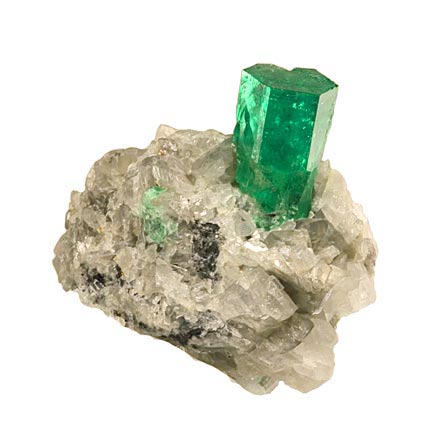 |
| From North Colombia. This well-terminated emerald on matrix comes from the Cosquez Mine in Muzo, Boyacá Department. It measures 4.1 x 3.4 x 2.7 cm. Inventory #18231. (Photo: John McLean) |
The emerald is being marketed by the name Carolina Emperor, but it’s being compared with a stone of similar size and quality owned by an empress—Russia’s Catherine II, “the Great.” We asked Ronald Ringsrud for his assessment. “I would say, that as real estate and the stock market lose their attraction,” he told us, “more people look to rarity in the form of metals and gems. The emerald from North Carolina is something rare, collectible, and worthy.”
Ledford told the Charlotte Observer that the crystal was so big it looked like a 7 Up bottle, weighing 310 carats before being cut. The story also describes the mining method employed by Ledford and Adams.
Ledford told the Observer that, as the son of mica miner, he “more or less grew up on” mining. Now he can retire on it. But, he says, he won’t stop now. See images of the cut stone at CNN. [back to top]
Recycle Bin
Some items of interest to mineral enthusiasts, featured in Palagems Reflective Index, our colored gemstone newsletter…
Mineral Mélange
Rubellite matrix offered at Burma sale
The 29th Gems & Jade Sale was held August 20–24 in Yangon, Burma, by the Union of Myanmar Economic Holdings Limited. Amongst the offerings was: “Magnificent Pink Tourmaline (Rubellite) Crystals with quartz and feldspar in matrix weighing ( 19 ) kilogram, the starting price Euro ( 5 ) million.”
Coincidentally, we were sent photographs of this overwhelming item, courtesy Kyaw Thu.
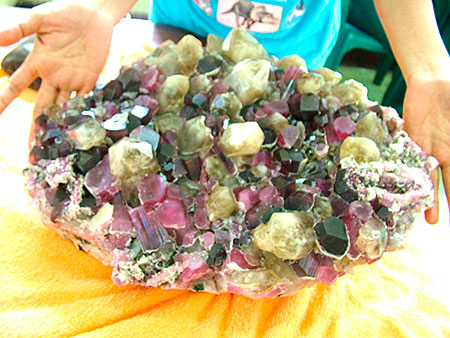 |
| Rich and fruity. Rubellite matrix from Let-Pan-Hla Mine, operated by UMEHL, which were to be exhibited at the sale this month. The crystals—about 150 in all—are 1–1.5 inches. (Photos courtesy Kyaw Thu) |
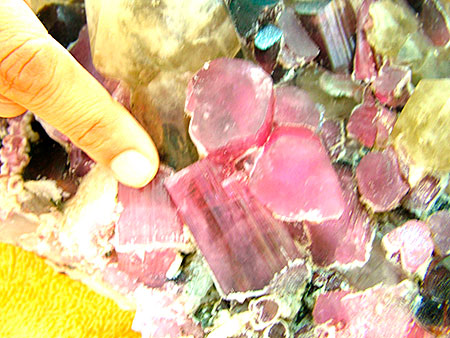 |
[back to top]
Going for the Gold
Famous ingot got gone
The late Mel Fisher left a collection of artifacts, from his famous treasure hunting, to the Maritime Heritage Museum named for him in Key West. On August 18, perhaps the single most memorable article in the museum was lifted—and then lifted. For 25 years, a hands-on exhibit has allowed goers to do a dumbbell curl with a $550,000 gold bar, from within a specially designed display case, until it was stolen on the 18th. Video of the still-at-large suspects is on YouTube.
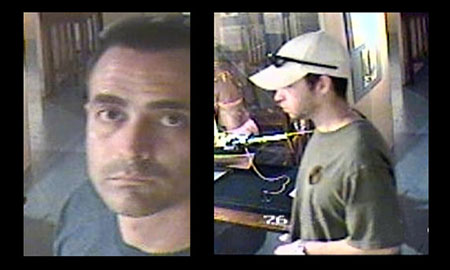 |
| Would you mind stepping up a little closer? Suspects were not shy about letting security cameras get a good look. |
To publicize the theft, the museum started a Facebook page of museum-goer memories. Thomas Gidus, who counts treasure hunting and local history amongst his interests, posted several clippings of thefts from over the years on TreasureNet. [back to top]
— End October Newsletter • Published 10/4/10 —
August 2010 Newsletter
Shows and Exhibitions
- East Coast Gem, Mineral & Fossil Show: August 13–15, 2010
- Colorado Mineral & Fossil Show: September 15–19, 2010
Pala International News
Mineral and Mineralogy News
- Father-and-Son Cover Stars: Jon and Max Sigerman
- William Pinch, Collector
- Lengthy Landslide: Untersulzbach Goes Unter
- News Briefs
- What’s Hot In Tucson 2010
- CA to drop state rock?
- “Bahia” Emerald trial postponed—again
Recycle Bin
Shows and Sales
East Coast Gem, Mineral & Fossil Show: August 13–15, 2010
Bill Larson featured exhibitor at Springfield show
This year’s East Coast Show will present Bill Larson as its featured exhibitor. Past featured collections have included those of Herb and Monika Obodda, the Sterling Hill Mining Museum, the Harvard Mineral Museum, Seaman Mineral Museum, Dawn Minette, Dan and Dianne Kile, and Gail and Jim Spann, amongst others.
Bill also will speak on Saturday, August 14, at 1:00 p.m., on the topic of “Mining, Minerals & Gems from The Legendary Valley of Rubies, Mogok, Burma.” Other speakers this year are Bob Jones, Nancy Millard, and Kevin Downey.
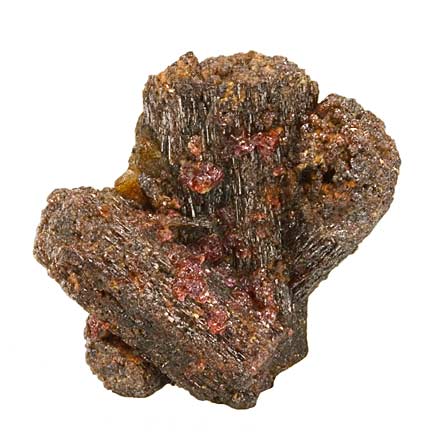 |
| 2-for-1: Mogok doesn’t produce only ruby. The above specimen features four large, crisscrossing painites adorned with ruby crystals. From the Wetloo Mine. See two other views at Palaminerals.com. (Photo: John McLean) |
Nearly 200 dealers, designers, lapidaries, and publishers from the U.S. and abroad will be featured at the show.
What: East Coast Gem, Mineral & Fossil Show
When: August 13–15, 2010
Where: Better Living Center at the Eastern States Exposition, West Springfield, Massachusetts
[back to top]
Pala at Colorado Mineral & Fossil Show
September 15–19, 2010
Pala International will be at the Colorado Mineral & Fossil Show.
- When: Sept. 15–19, 2010
- Where: Holiday Inn Denver–Central, 4849 Bannock St.
- Room 183
- Hours:
Wed.–Sat.: 10 a.m.– 6 p.m.
Sun.: 10 a.m.– 5 p.m.
We look forward to seeing our many friends there. For more information visit the show website.
 |
| Fluorite from the Sunnyside Mine in Colorado’s San Juan County, 3.7 x 3.9 x 3.5 cm. This older specimen is very glassy and features a few rhodochrosites. It’s available. (Photo: John McLean) |
Visit the Pala International Show Schedule for future events. [back to top]
While in Denver…
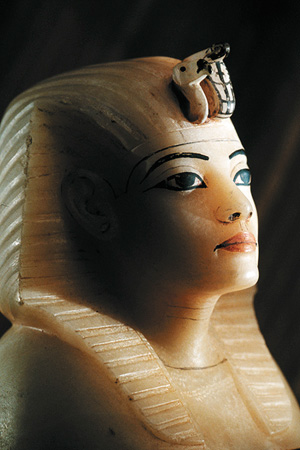 |
| Photo: Kenneth Garrett © 2008 National Geographic |
…you have a chance to see Tutankhamun: The Golden King and the Great Pharaohs at the Denver Art Museum, which includes 50 artifacts from the tomb of this 14th century C.E. son of a heretic, such as the canopic stopper at right carved in the young king’s (or another’s?) likeness from translucent calcite, and used to seal canopic chest compartments containing his internal organs.
The exhibit also features 50 additional objects spanning 2,000 years of Egyptian his- and her-story, such as the famous broad collar (wesekh) found on the body of Neferuptah, princess of an earlier dynasty, composed of six rows of feldspar and carnelian beads, inlaid teardrops, and golden falcon heads. [back to top]
Pala International News
Pala’s Featured Specimens: Rhodochrosite from Peru, Phenakite from Burma
This month we feature two new specimens the Larsons picked up while at the Sainte-Marie-aux-Mines show last month: a rhodochrosite from Peru and a phenakite from Burma. (Bill Larson tells us that a report on the show is forthcoming…)
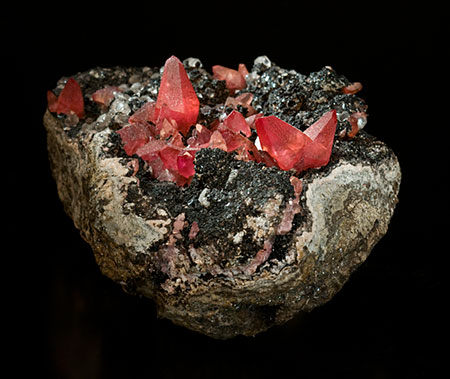 |
| Rhodochrosite from Peru. Price upon request. (Photo: Jason Stephenson) |
The rhodochrosite comes to us from the Uchucchacua Mine in the Oyon province, Lima Department in Peru. Clusters of intense orangey-red rhodochrosite scalenohedron crystals mixed with tiny fluorite crystals are scattered on a black gritty matrix. It features several pristine rhodochrosite crystals around 1 cm. in length and a twin perched right on the edge of the specimen.
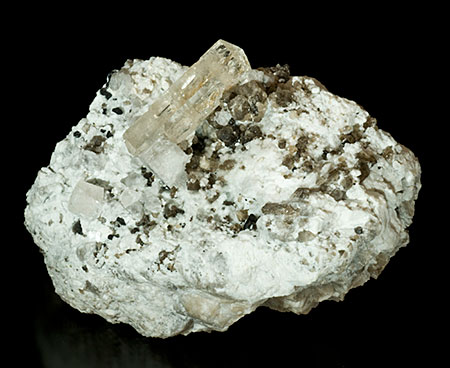 |
| Phenakite from Mogok, Burma. Price upon request. (Photo: Jason Stephenson) |
The phenakite come to us from Kat Chay Mine, Momeik, Mogok, Sagaing District, Mandalay Division, Burma. A doubly terminated phenakite crystal is positioned amongst a salt-and-pepper matrix of feldspar and quartz. The phenakite crystal is 3.7 x 1.2 x 1.0 cm. and very gemmy with a glassy drill bit termination.
Mineral and Mineralogy News
Father-and-Son Cover Stars
Jon and Max Sigerman profiled in Marin Independent
Visitors to the Pala International websites by now are familiar with how a love of fine mineral specimens can be passed from the older generation to the younger. But what of the reverse? That’s the case with Max Sigerman and his father, Jon, as presented in a July 5 article in the Marin Independent Journal.
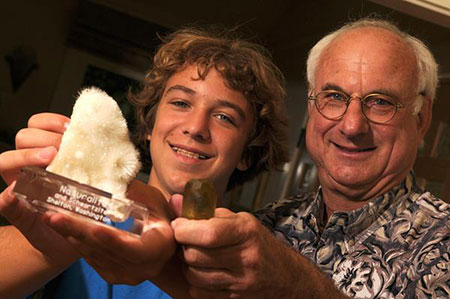 |
| Father-and-son mineral collectors Max, 13, and Jon Sigerman, 62, divide their hobby into two parts: field collecting and attending events, such as last month’s San Francisco Fine Mineral Show. (Photo: Frankie Frost, republished with permission from Marin Independent Journal) |
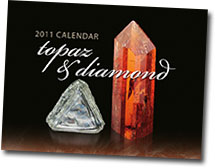 |
| Also featured in the calendar is a topaz group from Pakistan’s Shigar Valley, from Bill Larson’s collection. See the calendar at the East Coast Show, or visit the Lithographie website. |
The article tells how Max got bitten by the bug Culicidae cobbingia—and why his father went along with it.
You may recognize Max from the first two episodes of BlueCap Productions’ New Crystal Hunters series. And you may recognize selections from their collection from the covers of various publications, the latest of which is the 2011 calendar from Lithographie. The Sigermans provided the macle twinned diamond pictured at right, in keeping with the theme “Topaz and Diamond.” [back to top]
William Pinch, Collector
Will Larson looks at an online gallery from a splendid collection
William Pinch has collected minerals for more than fifty years. I’ve had the pleasure of doing business with him and spending time gaining knowledge from him at the many mineral shows we both attend.
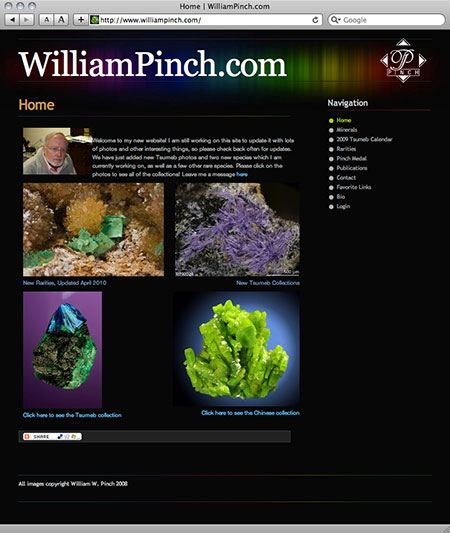 |
His website, WilliamPinch.com, contains an allotment of beautiful photographs of specimens from the William Pinch collection. This includes a comprehensive locality collection from Tsumeb, a Chinese mineral collection, and a Rarities section. The website is very well laid out and the photographs are beautiful; so I highly recommend any mineral enthusiast to check it out!
The Tsumeb collection has three sections and contains many rare species I’ve never seen in person from this locality, as well as the more common species, all of which are beautiful. One of my favorites is in Tsumeb Gallery 1, the second image, of the luscious velvet blue azurite crystal. It jumps right off the screen as if you were holding it in person. But don’t stop there; continue to browse, as there are many beautiful things in Galleries 2 and 3 of the Tsumeb collection.
The next collection is the Chinese mineral collection, which covers a wide range of minerals from all over the country. One of my favorite pieces is a group of spiky electric green crystals of antlerite with brochantite. This Chinese mineral collection can really give you a great idea of the many different species that come from all over China.
The Rarities collection contains few specimens, but these are some of the rarest minerals in the world, most of which I’ve never heard of or seen before.
The next step is for you to click and go to it. Enjoy this beautiful collection! [back to top]
Lengthy Landslide: Untersulzbach Goes Unter
Famed epidote locality is closed for a season
Pala is truly “International” when we have visitors to Palaminerals.com from across the pond. One eagle-eyed reader, our Austrian friend Nikolaus Lackner, noticed a locality contradiction in one of our epidote offerings from his part of the world. (We had inadvertently placed Knappenwand in Tyrol instead of Salzburg.) Nikolaus, who is concentrating on mining for emeralds, is intimately familiar with Knappenwand, and last month had just returned from a 16-day mining trip to the area.
This spring there has been a gigantic rockslide in the Untersulzbach Valley. Really gigantic! The whole valley is closed (no entry allowed at all) since 22. of April. The actual mining site itself, as it is in a half-cave-like pocket, is not destroyed, but can’t be worked, and, can’t be accessed. The street is gone and geologists doubt that the street will ever be built up again. The rubble—with boulders as big as mansions—spreads for miles, even blocks another mine, the Schaubergwerk Hochfeld.
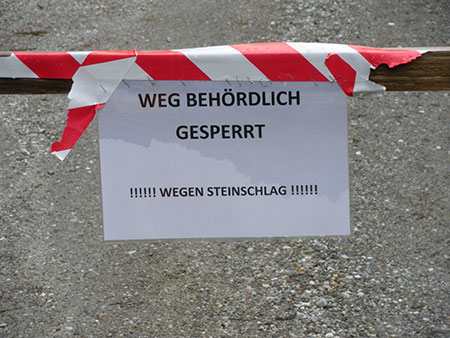 |
| “Way Officially Closed Due to Falling Rocks.” (Photo: Peter Rieder) |
Nikolaus went on to say that the situation is even sadder for the rockhounds than for the dealers. Uncontrolled blasts from illegal mining during the 20th century blew many crystals into the forest floor below the mine, allowing for nice specimens to be found by Nikolaus and his fellow scouts. “Now that forest is gone,” he told us, due to the landslide. He kindly obtained from Peter Rieder the photographs that show the extent of the landslide’s impact.
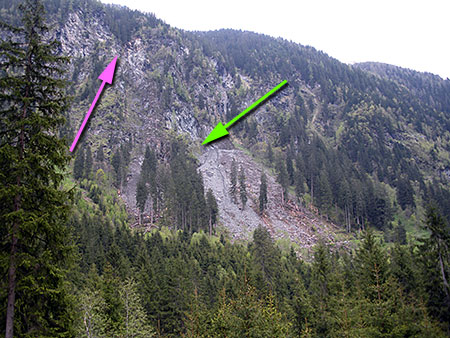 |
| Trees to matchsticks. Above: The green arrow points to the location of the entrance to the Knappenwand mine. The pink arrow indicates the ridge that gave way, causing the slide. Click for enlargement. (Note: The mine entrance is detected in the enlargement only by a barely discernable wooden structure.) Below: Few trees stand in a forest that once held specimens that had been blasted out in the course of illegal mining. (Photos: Peter Rieder) |
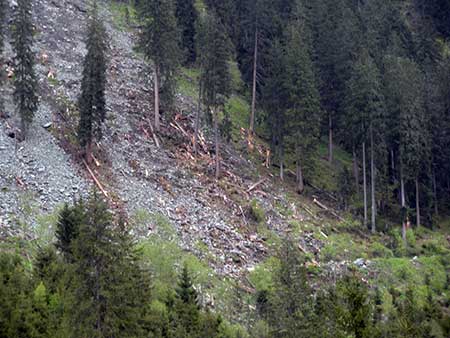 |
According to an April 22 story in the Salzburger Nachtrichten (no longer available, but copied on Forum Gipfeltreffen), the Untersulzbachtal Valley was accessible only by a footpath; even so, a restraining order was in effect. The story stated that a January landslide had fallen all the way to the valley trail and hut, with the hut barely escaping demolition by a large boulder. The landslide had the potential of disrupting not only specimen-scouting, but also the movement of cattle via alpine trails, the story said.
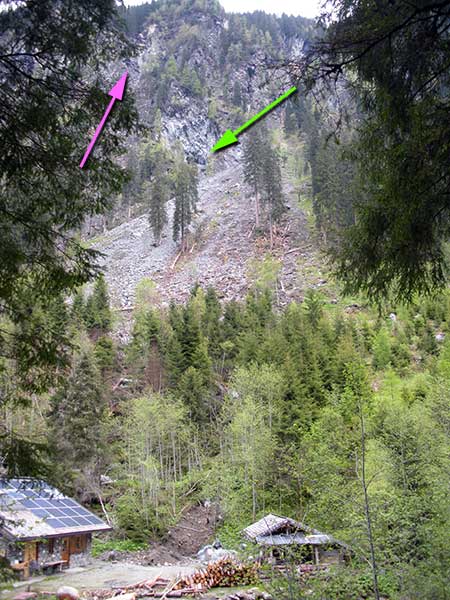 |
| Whew! Above: The green arrow points to the entrance to the mine, perched above the fray. Click for enlargement. Some of the fray dropped from the ridge that is indicated by the pink arrow (an enlargement of this latter area is included in the following pair of photos). Below: A large boulder lies in a brook, having missed the mine huts. (Photos: Peter Rieder) |
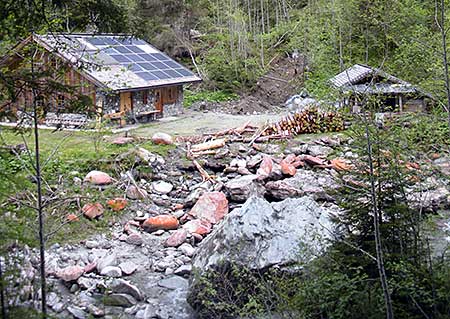 |
Until the disaster, the Knappenwand (literally “miners’ wall”) mine was open for visiting during summer months. For more information on the mine from Nikolaus Lackner, as well as some stunning epidote photographs from the Naturhistorisches Museum Wien, see his entry on GemologyOnline.
 |
| Above: The pink arrow points to a slide area enlarged below.
The green arrow, again, indicates the entrance to the Knappenwand mine. Click for enlargement. Below: A detail of the slide area source. The surface has given way, baring the underlying rock. (Photos: Peter Rieder) |
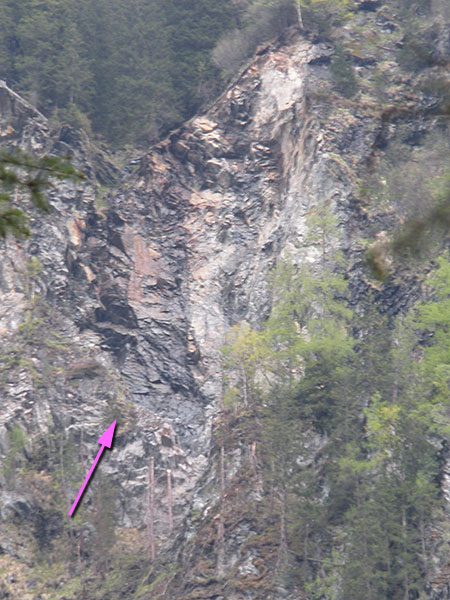 |
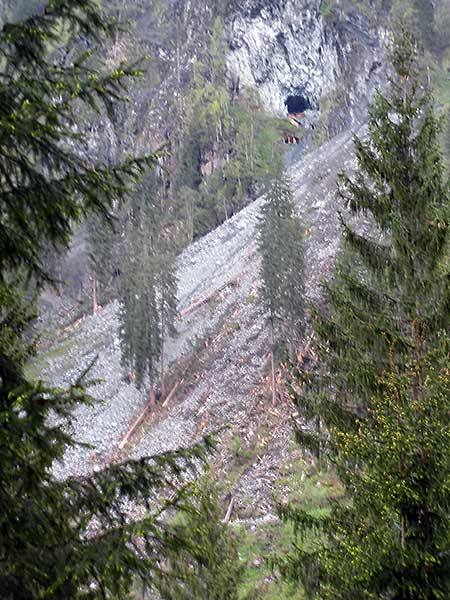 |
| Uneasy access. Two views of the mine entrance. Looks like the outhouse has been taken out. (Photos: Peter Rieder) |
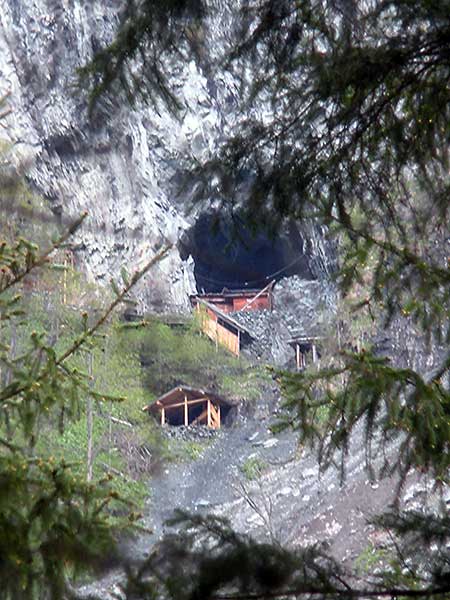 |
For an amazing photograph of the wintry mine entrance, and showing the green epidote-bearing ore that surrounds it, see Lapis.de. The photo caption there states that the mine’s aerial ropeway and outhouse were destroyed, but the mine itself was spared.
 |
| Museum piece. This super-glassy epidote cluster from Knappenwand features excellent terminations, so much so that it once was housed by the American Museum of Natural History. Available from Palaminerals.com. (Photo: John McLean) |
[back to top]
News Briefs
Rock on…
 |
-
BlueCap Productions: What’s Hot In Tucson 2010 is now available. Co-hosts David Wilber and Bob Jones take you through the shows in the course of three DVDs. Included is an interview with Will Larson, who was the featured exhibitor at Westward Look.
Also see Eberhard Equit – An Intimate Talk, a DVD filmed on location in the mineral artist’s Germany, and The Minette Collection, a 2002 film shot by Wendell Wilson which profiles James and Dawn Minette and their world class thumbnail collection, which was sold off at Tucson in 2008. As always Pala people get a 10% discount: enter the code palaintl during checkout - New York Times: California considers dropping its state rock. The-Vug.com’s Justin Zzyzx is quoted at the end, via Twitter: “Dear gloria romero, you have picked the wrong nerds to mess with!” He explains more here
- Diamonds.net: “Bahia” Emerald ruling postponed; trial set for September 8
[back to top]
Recycle Bin
Last month we celebrated the close of Pala International’s 40th year, and the beginning of our 41st, with a new name for our gem newsletter: Palagems Reflective Index. In this Recycle Bin we point to two stories from that newly dubbed edition, reflecting on Nature’s incredible beauty-bounty as well as its capacity for calamity…
A Collection in Living Color
ICA quarterly profiles the Metzger Collection
In July’s Palagems Reflective Index we looked at a feature story in the Spring 2010 of InColor, the quarterly issued by the International Colored Stone Association (ICA). It surrounds the story and collection of Edward A. Metzger, a connoisseur collector of colored stones. Pala’s Bill Larson is slated to contribute the foreword to the upcoming book about the collection.
While the collection includes very few mineral crystals, co-authors of the InColor article, Elise Skalwold and Dr. William Bassett, “approach the study of gemstones from a mineralogy perspective,” Elise told us. “Everything about the cut stones relates to the original mineral's crystallographic properties.”
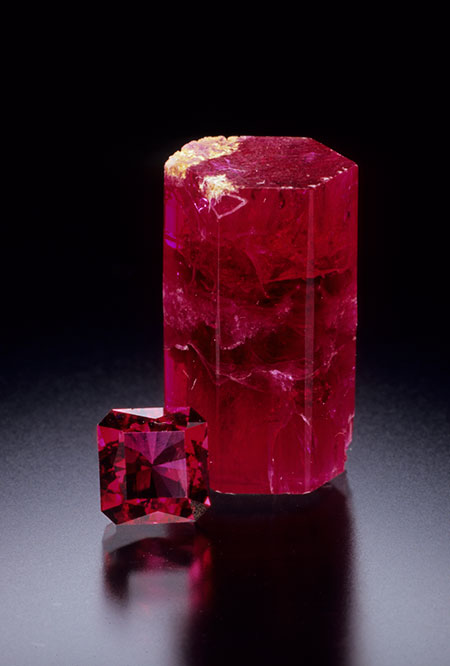 |
| Classic Jeff Scovil “rough & cut” portrait. A 1.19-carat cut red beryl alongside its natural sister, a 1.70-cm. double-terminated crystal. Both originate from the Wah Wah Mountains, Beaver County, Utah. (Photo: Jeff Scovil) |
“Jeff's rough-and-cut red beryl portrait is iconic for the Metzger Collection,” she said, regarding the photograph above by Jeff Scovil, ”even though this crystal is the only significant mineral specimen it includes.”
When I first came across the nearly euhedral red beryl crystal and its flawless faceted counterpart, not only did I immediately think of Jeff's signature rough-and-cut style, but also how to tie this collection into our academic focus. Jeff’s knowledge of mineralogy along with his skill at capturing the special qualities of gems and minerals has made this collection come alive in print, as the InColor article demonstrates.
Elise told us that the forthcoming book will include portraits by Scovil of minerals (from other collections) representative of the faceted stones in this collection, to illustrate discussion of the attributes of the gems themselves. “This would have greatly pleased Ed Metzger with his insatiable curiosity about what makes a gem a gem!”
Read more in our “A Collection in Living Color.” [back to top]
Hard Science and Hard Choices,
to Stop a Deep Water Disaster
John Koivula asks whether a disadvantage can be turned into an advantage in capping the Deepwater Horizon
With persistent attention focused on the risk of underwater oil leakage, we’re pleased to point to a proposal offered by none other than John Koivula—yes—the world authority on gemstone inclusions. “What the hellyerite does he know about the subject?” you ask. We wondered, too. Then we read his simple and elegant solution offered in the three pages of “Possible Solution to Stop the Deep Water Oil Leak at its Source.”
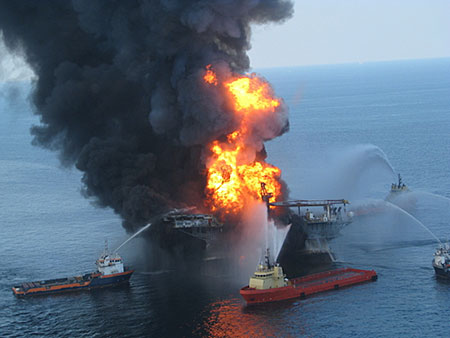 |
| Innovative thinking—of John Koivula’s sort—clearly is in order. A report issued July 27 by The Center for Public Integrity questions whether the spraying of tons of saltwater by private boats might have led to the collapse of the Deepwater Horizon platform. Who’d a thunk it? {Photo: U.S. Coast Guard) |
[back to top]
— End August Newsletter • Published 8/3/10 —